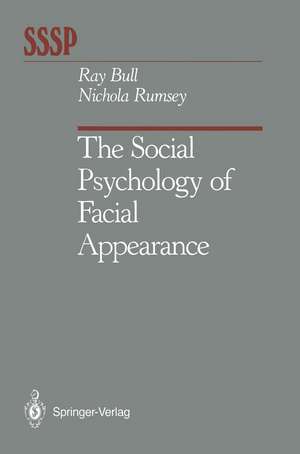The Social Psychology of Facial Appearance: Springer Series in Social Psychology
Autor Ray Bull, Nichola Rumseyen Limba Engleză Paperback – 10 oct 2011
Din seria Springer Series in Social Psychology
-
 Preț: 40.07 lei
Preț: 40.07 lei - 15%
 Preț: 643.48 lei
Preț: 643.48 lei -
 Preț: 387.96 lei
Preț: 387.96 lei -
 Preț: 384.48 lei
Preț: 384.48 lei -
 Preț: 386.00 lei
Preț: 386.00 lei - 15%
 Preț: 694.69 lei
Preț: 694.69 lei -
 Preț: 394.87 lei
Preț: 394.87 lei -
 Preț: 387.96 lei
Preț: 387.96 lei - 15%
 Preț: 642.36 lei
Preț: 642.36 lei -
 Preț: 389.31 lei
Preț: 389.31 lei - 15%
 Preț: 640.06 lei
Preț: 640.06 lei - 15%
 Preț: 696.02 lei
Preț: 696.02 lei - 18%
 Preț: 891.17 lei
Preț: 891.17 lei -
 Preț: 392.60 lei
Preț: 392.60 lei - 18%
 Preț: 889.60 lei
Preț: 889.60 lei -
 Preț: 382.18 lei
Preț: 382.18 lei -
 Preț: 387.75 lei
Preț: 387.75 lei -
 Preț: 388.90 lei
Preț: 388.90 lei -
 Preț: 384.48 lei
Preț: 384.48 lei - 18%
 Preț: 726.37 lei
Preț: 726.37 lei -
 Preț: 384.86 lei
Preț: 384.86 lei - 18%
 Preț: 779.57 lei
Preț: 779.57 lei -
 Preț: 380.07 lei
Preț: 380.07 lei -
 Preț: 387.20 lei
Preț: 387.20 lei - 18%
 Preț: 725.43 lei
Preț: 725.43 lei -
 Preț: 386.22 lei
Preț: 386.22 lei -
 Preț: 387.38 lei
Preț: 387.38 lei - 15%
 Preț: 640.71 lei
Preț: 640.71 lei - 18%
 Preț: 777.03 lei
Preț: 777.03 lei -
 Preț: 386.00 lei
Preț: 386.00 lei - 15%
 Preț: 639.73 lei
Preț: 639.73 lei -
 Preț: 382.18 lei
Preț: 382.18 lei -
 Preț: 390.25 lei
Preț: 390.25 lei - 18%
 Preț: 781.45 lei
Preț: 781.45 lei -
 Preț: 382.75 lei
Preț: 382.75 lei -
 Preț: 386.99 lei
Preț: 386.99 lei -
 Preț: 382.75 lei
Preț: 382.75 lei -
 Preț: 428.46 lei
Preț: 428.46 lei - 15%
 Preț: 533.72 lei
Preț: 533.72 lei -
 Preț: 388.52 lei
Preț: 388.52 lei -
 Preț: 393.13 lei
Preț: 393.13 lei -
 Preț: 389.11 lei
Preț: 389.11 lei -
 Preț: 387.75 lei
Preț: 387.75 lei
Preț: 392.60 lei
Nou
Puncte Express: 589
Preț estimativ în valută:
75.12€ • 78.65$ • 62.16£
75.12€ • 78.65$ • 62.16£
Carte tipărită la comandă
Livrare economică 05-19 aprilie
Preluare comenzi: 021 569.72.76
Specificații
ISBN-13: 9781461283485
ISBN-10: 1461283485
Pagini: 372
Ilustrații: IX, 355 p.
Dimensiuni: 155 x 235 x 20 mm
Greutate: 0.52 kg
Ediția:Softcover reprint of the original 1st ed. 1988
Editura: Springer
Colecția Springer
Seria Springer Series in Social Psychology
Locul publicării:New York, NY, United States
ISBN-10: 1461283485
Pagini: 372
Ilustrații: IX, 355 p.
Dimensiuni: 155 x 235 x 20 mm
Greutate: 0.52 kg
Ediția:Softcover reprint of the original 1st ed. 1988
Editura: Springer
Colecția Springer
Seria Springer Series in Social Psychology
Locul publicării:New York, NY, United States
Public țintă
ResearchCuprins
1. Introduction.- 2. The Role of Facial Appearance in Liking, Dating, and Marriage.- The Effects of Facial Appearance on Liking.- The Effects of Facial Appearance on Meeting and Dating.- The Role of Facial Appearance in Marriage.- Conclusion.- 3. The Effects of Facial Appearance in Persuasion, Politics, Employment, and Advertising.- Facial Appearance and Persuasion.- The Role of Facial Appearance in Politics.- The Role of Facial Appearance in Employment.- Facial Appearance and Advertising.- General Conclusion.- 4. Facial Appearance and the Criminal Justice System.- The Extent to Which People Expect a Relationship Between Facial Appearance and Criminality.- The Effects of Facial Appearance on Recognizability.- Is There, in Fact, a Relationship Between Facial Appearance and Criminality?.- Facial Appearance and Attributions of Responsibility.- The Effects of Facial Appearance on “Jurors”.- Overall Conclusion.- 5. The Effects of Facial Appearance in the Educational System.- The Effects of Facial Appearance on Teachers’ Expectations.- The Effects of Facial Appearance on Academic Work.- Is There Really a Relationship Between Facial Appearance and Academic Performance?.- The Effects of Teachers’ Facial Appearance.- Conclusion.- 6. The Effects of Children’s Facial Appearance on Adults and the Effects of Facial Appearance on Children.- Children’s Facial Appearance and Their Disciplining.- Adults’ Reactions to Infants’ Facial Appearance.- At What Age Can Children Discriminate Facial Attractiveness?.- At What Age Do Children Demonstrate Stereotyping Based on Facial Appearance?.- Overall Conclusion.- 7. The Social Psychology of Facial Disfigurement.- The Birth and Development of Facially Disadvantaged Children.- A Historical Perspective on Disfigurement andSociety.- Negative Stereotyping and Negative Attitudes Toward Disfigured Persons—Do They Exist?.- The Relationship Between Societal Values and the Demand for Cosmetic Surgery.- Social Interaction Involving Disfigured Persons.- What Are the Consequences of the Negative Reactions of Others?.- Studies of Helping Behavior Relevant to Facially Disfigured Persons.- The Behavior of Disfigured Persons Themselves.- Ways of Helping Facially Disfigured Persons.- Issues to Be Considered in Future Research.- Summary.- 8. How Can Psychologists Help Those Disadvantaged by Their Facial Appearance?.- Attitudes Toward Facially Disfigured Persons.- The Behavior and Attitudes of Facially Disadvantaged Persons.- Techniques of Attitude Change.- The Media—Enemies or Allies?.- How the Media Can Help.- The Provision of Health Services for Facially Disadvantaged Persons.- Ways of Offering Help Directly to Facially Disadvantaged People..- Conclusion.- 9. Some Final Remarks.- Other Studies Concerning the Social Psychological Aspects of Beauty.- What Is Facial Attractiveness?.- Individual Differences Between Perceivers.- Context Effects in Reactions to Faces.- Theoretical Explanations.- Further Points for Future Research.- References.- Author Index.


















